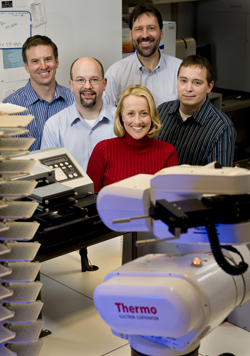
Jeffrey Conn, Ph.D., background, with, from left, Shaun Stauffer, Ph.D., David Weaver, Ph.D., Carrie Jones, Ph.D., and Craig Lindsley, Ph.D., at the Vanderbilt High-Throughput Screening Facility. photo by Joe Howell
VU, Janssen team in drug discovery effort
In a new model for drug discovery, Vanderbilt University and Janssen Pharmaceutica are joining forces to search for novel schizophrenia medicines.
A licensing and research alliance gives Janssen, a member of the Johnson & Johnson Family of Companies, exclusive license to certain existing compounds discovered at Vanderbilt that offer a fresh approach for treating schizophrenia. In addition, the agreement provides a framework for the discovery and licensing of additional novel compounds over the next three years.
Janssen will provide $10 million in licensing and committed research funding to P. Jeffrey Conn, Ph.D., director of the Vanderbilt Program in Drug Discovery, and up to $100 million in additional funding if compounds coming from the program meet defined steps in clinical development.
“This collaboration is a real milestone for the Program in Drug Discovery,” Conn said. “In my view, it's the first time that a major pharmaceutical company is partnering with an academic institution for this type of drug discovery.”
“Drug discovery is a top priority for our research enterprise, and this alliance underscores our growing position as a world leader in that area,” said Jeff Balser, M.D., Ph.D., associate vice chancellor for Health Affairs and dean of the School of Medicine. “Jeff and his team are making major strides in schizophrenia treatment and are also establishing a new paradigm for drug discovery in academic medical centers.”
Stef Heylen, M.D., chief medical officer for CNS Research and Early Development at Janssen, said that the collaboration highlights “the synergies between industry and academia that can help create solutions for addressing unmet medical needs. It is a great example of how we can work together with academia to better understand complex diseases and hopefully bring improved treatments to patients.”
Vanderbilt has recruited world-class drug discovery scientists from industry and put together state-of-the-art drug discovery infrastructure, including high throughput screening, medicinal chemistry, molecular pharmacology, drug metabolism and pharmacokinetic analysis, and in vivo efficacy testing, Conn said.
The program has the capacity to create novel compounds and optimize them as drug candidates for clinical testing.
“Vanderbilt deserves a lot of institutional credit for creating an environment that makes this type of alliance possible,” Conn said. “A willingness by the institution's leadership to be a trendsetter and break away from traditional academic models to build intense team-oriented discovery efforts is critical.”
Conn also noted that Brian Laden, Ph.D., and other colleagues in Technology Transfer & Enterprise Development “played key roles in navigating the complex issues that are inevitably involved in negotiating a collaboration such as this.”
The alliance with Janssen — one of the world's leading developers of drugs for the treatment of schizophrenia — builds on the ongoing discovery efforts of Conn and his colleagues.
The team has identified novel molecules that interact with a specific neurotransmitter receptor, which pre-clinical testing in animal models suggests will have efficacy in treating schizophrenia.
“The advantage of these molecules is that they use a completely different mechanism than any current antipsychotic agent,” Conn said.
Currently available antipsychotic agents are effective in reducing hallucinations and delusions — the “positive” symptoms of schizophrenia — Conn said, but they are less effective against the cognitive deficits and the “negative” symptoms of schizophrenia, such as social withdrawal and lack of ability to experience pleasure.
Schizophrenia affects more than 2 million Americans, about 1 percent of the population age 18 and older.
“Our hope is that the agents coming from our efforts will have therapeutic benefit for both the positive and negative symptoms and for the cognitive deficits of schizophrenia,” Conn said.
Conn, along with Craig Lindsley, Ph.D., director of Medicinal Chemistry for the Program in Drug Discovery, and their colleagues have pioneered an approach of targeting neurotransmitter receptors with “allosteric modulators” — compounds that do not directly activate or block receptors, but instead work like a dimmer switch in an electrical circuit.
The ability of these compounds to subtly “turn up” or “turn down” receptor activity gives them advantages over direct activators or blockers, Conn said.
“For the receptors we're targeting, no one's been successful developing drugs because of selectivity issues — all the drug candidates have affected too many related receptor targets,” he said.
The team has focused on metabotropic glutamate receptors and muscarinic acetylcholine receptors, which have roles in brain circuits that are important for normal physiological processes and for brain diseases including Alzheimer's, Parkinson's, schizophrenia, epilepsy and drug dependence.
Conn's colleagues in the schizophrenia drug discovery effort include Lindsley and Shaun Stauffer, Ph.D., associate director of Medicinal Chemistry, who will oversee chemical optimization of compounds for testing in the clinic.
David Weaver, Ph.D., directs the high-throughput screening and molecular pharmacology efforts of the program, and will serve as the pharmacology team leader for this research effort.
Carrie Jones, Ph.D., director of Behavioral Pharmacology in the program, will spearhead the screening of lead compounds in rodent behavior models that predict efficacy in the treatment of schizophrenia.













